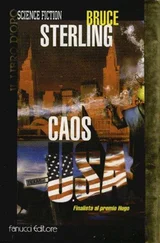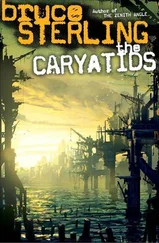Bruce Sterling - The Hacker Crackdown
Здесь есть возможность читать онлайн «Bruce Sterling - The Hacker Crackdown» весь текст электронной книги совершенно бесплатно (целиком полную версию без сокращений). В некоторых случаях можно слушать аудио, скачать через торрент в формате fb2 и присутствует краткое содержание. Жанр: Фантастика и фэнтези, на английском языке. Описание произведения, (предисловие) а так же отзывы посетителей доступны на портале библиотеки ЛибКат.
- Название:The Hacker Crackdown
- Автор:
- Жанр:
- Год:неизвестен
- ISBN:нет данных
- Рейтинг книги:4 / 5. Голосов: 1
-
Избранное:Добавить в избранное
- Отзывы:
-
Ваша оценка:
- 80
- 1
- 2
- 3
- 4
- 5
The Hacker Crackdown: краткое содержание, описание и аннотация
Предлагаем к чтению аннотацию, описание, краткое содержание или предисловие (зависит от того, что написал сам автор книги «The Hacker Crackdown»). Если вы не нашли необходимую информацию о книге — напишите в комментариях, мы постараемся отыскать её.
The Hacker Crackdown — читать онлайн бесплатно полную книгу (весь текст) целиком
Ниже представлен текст книги, разбитый по страницам. Система сохранения места последней прочитанной страницы, позволяет с удобством читать онлайн бесплатно книгу «The Hacker Crackdown», без необходимости каждый раз заново искать на чём Вы остановились. Поставьте закладку, и сможете в любой момент перейти на страницу, на которой закончили чтение.
Интервал:
Закладка:
The pursuit of the E911 Document stopped with the Steve Jackson Games raid. As we have seen, there were hundreds, perhaps thousands of computer users in America with the E911 Document in their possession. Theoretically, Chicago had a perfect legal right to raid any of these people, and could have legally seized the machines of anybody who subscribed to *Phrack.* However, there was no copy of the E911 Document on Jackson's Illuminati board. And there the Chicago raiders stopped dead; they have not raided anyone since.
It might be assumed that Rich Andrews and Charlie Boykin, who had brought the E911 Document to the attention of telco security, might be spared any official suspicion. But as we have seen, the willingness to "cooperate fully" offers little, if any, assurance against federal anti-hacker prosecution.
Richard Andrews found himself in deep trouble, thanks to the E911 Document. Andrews lived in Illinois, the native stomping grounds of the Chicago Task Force. On February 3 and 6, both his home and his place of work were raided by USSS. His machines went out the door, too, and he was grilled at length (though not arrested). Andrews proved to be in purportedly guilty possession of: UNIX SVR 3.2; UNIX SVR 3.1; UUCP; PMON; WWB; IWB; DWB; NROFF; KORN SHELL '88; C++; and QUEST, among other items. Andrews had received this proprietary code -- which AT&T officially valued at well over $250,000 -- through the UNIX network, much of it supplied to him as a personal favor by Terminus. Perhaps worse yet, Andrews admitted to returning the favor, by passing Terminus a copy of AT&T proprietary STARLAN source code.
Even Charles Boykin, himself an AT&T employee, entered some very hot water. By 1990, he'd almost forgotten about the E911 problem he'd reported in September 88; in fact, since that date, he'd passed two more security alerts to Jerry Dalton, concerning matters that Boykin considered far worse than the E911 Document.
But by 1990, year of the crackdown, AT&T Corporate Information Security was fed up with "Killer." This machine offered no direct income to AT&T, and was providing aid and comfort to a cloud of suspicious yokels from outside the company, some of them actively malicious toward AT&T, its property, and its corporate interests. Whatever goodwill and publicity had been won among Killer's 1,500 devoted users was considered no longer worth the security risk. On February 20, 1990, Jerry Dalton arrived in Dallas and simply unplugged the phone jacks, to the puzzled alarm of Killer's many Texan users. Killer went permanently off-line, with the loss of vast archives of programs and huge quantities of electronic mail; it was never restored to service. AT&T showed no particular regard for the "property" of these 1,500 people. Whatever "property" the users had been storing on AT&T's computer simply vanished completely.
Boykin, who had himself reported the E911 problem, now found himself under a cloud of suspicion. In a weird private-security replay of the Secret Service seizures, Boykin's own home was visited by AT&T Security and his own machines were carried out the door.
However, there were marked special features in the Boykin case. Boykin's disks and his personal computers were swiftly examined by his corporate employers and returned politely in just two days -- (unlike Secret Service seizures, which commonly take months or years). Boykin was not charged with any crime or wrongdoing, and he kept his job with AT&T (though he did retire from AT&T in September 1991, at the age of 52).
It's interesting to note that the US Secret Service somehow failed to seize Boykin's "Killer" node and carry AT&T's own computer out the door. Nor did they raid Boykin's home. They seemed perfectly willing to take the word of AT&T Security that AT&T's employee, and AT&T's "Killer" node, were free of hacker contraband and on the up-and-up.
It's digital water-under-the-bridge at this point, as Killer's 3,200 megabytes of Texan electronic community were erased in 1990, and "Killer" itself was shipped out of the state.
But the experiences of Andrews and Boykin, and the users of their systems, remained side issues. They did not begin to assume the social, political, and legal importance that gathered, slowly but inexorably, around the issue of the raid on Steve Jackson Games.
#
We must now turn our attention to Steve Jackson Games itself, and explain what SJG was, what it really did, and how it had managed to attract this particularly odd and virulent kind of trouble. The reader may recall that this is not the first but the second time that the company has appeared in this narrative; a Steve Jackson game called GURPS was a favorite pastime of Atlanta hacker Urvile, and Urvile's science-fictional gaming notes had been mixed up promiscuously with notes about his actual computer intrusions.
First, Steve Jackson Games, Inc., was *not* a publisher of "computer games." SJG published "simulation games," parlor games that were played on paper, with pencils, and dice, and printed guidebooks full of rules and statistics tables. There were no computers involved in the games themselves. When you bought a Steve Jackson Game, you did not receive any software disks. What you got was a plastic bag with some cardboard game tokens, maybe a few maps or a deck of cards. Most of their products were books.
However, computers *were* deeply involved in the Steve Jackson Games business. Like almost all modern publishers, Steve Jackson and his fifteen employees used computers to write text, to keep accounts, and to run the business generally. They also used a computer to run their official bulletin board system for Steve Jackson Games, a board called Illuminati. On Illuminati, simulation gamers who happened to own computers and modems could associate, trade mail, debate the theory and practice of gaming, and keep up with the company's news and its product announcements.
Illuminati was a modestly popular board, run on a small computer with limited storage, only one phone-line, and no ties to large-scale computer networks. It did, however, have hundreds of users, many of them dedicated gamers willing to call from out-of-state.
Illuminati was *not* an "underground" board. It did not feature hints on computer intrusion, or "anarchy files," or illicitly posted credit card numbers, or long-distance access codes. Some of Illuminati's users, however, were members of the Legion of Doom. And so was one of Steve Jackson's senior employees -- the Mentor. The Mentor wrote for *Phrack,* and also ran an underground board, Phoenix Project -- but the Mentor was not a computer professional. The Mentor was the managing editor of Steve Jackson Games and a professional game designer by trade. These LoD members did not use Illuminati to help their *hacking* activities. They used it to help their *game-playing* activities -- and they were even more dedicated to simulation gaming than they were to hacking.
"Illuminati" got its name from a card-game that Steve Jackson himself, the company's founder and sole owner, had invented. This multi-player card-game was one of Mr Jackson's best-known, most successful, most technically innovative products. "Illuminati" was a game of paranoiac conspiracy in which various antisocial cults warred covertly to dominate the world. "Illuminati" was hilarious, and great fun to play, involving flying saucers, the CIA, the KGB, the phone companies, the Ku Klux Klan, the South American Nazis, the cocaine cartels, the Boy Scouts, and dozens of other splinter groups from the twisted depths of Mr. Jackson's professionally fervid imagination. For the uninitiated, any public discussion of the "Illuminati" card-game sounded, by turns, utterly menacing or completely insane.
And then there was SJG's "Car Wars," in which souped-up armored hot-rods with rocket-launchers and heavy machine-guns did battle on the American highways of the future. The lively Car Wars discussion on the Illuminati board featured many meticulous, painstaking discussions of the effects of grenades, land-mines, flamethrowers and napalm. It sounded like hacker anarchy files run amuck.
Читать дальшеИнтервал:
Закладка:
Похожие книги на «The Hacker Crackdown»
Представляем Вашему вниманию похожие книги на «The Hacker Crackdown» списком для выбора. Мы отобрали схожую по названию и смыслу литературу в надежде предоставить читателям больше вариантов отыскать новые, интересные, ещё непрочитанные произведения.
Обсуждение, отзывы о книге «The Hacker Crackdown» и просто собственные мнения читателей. Оставьте ваши комментарии, напишите, что Вы думаете о произведении, его смысле или главных героях. Укажите что конкретно понравилось, а что нет, и почему Вы так считаете.



